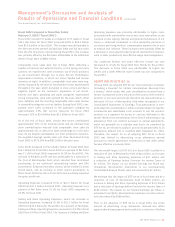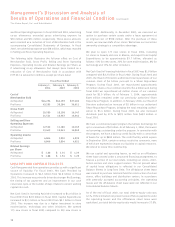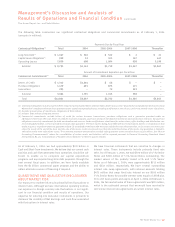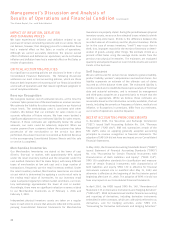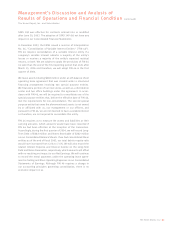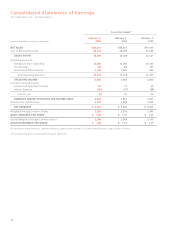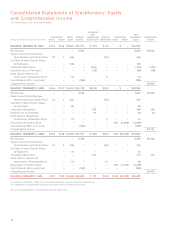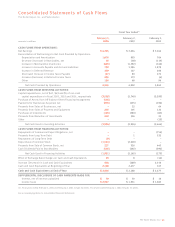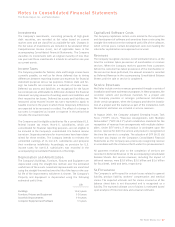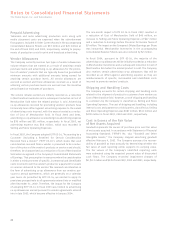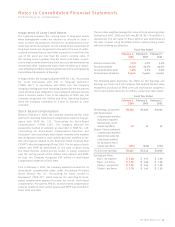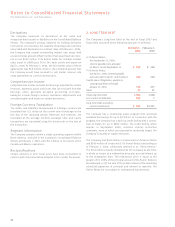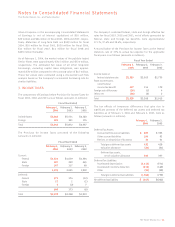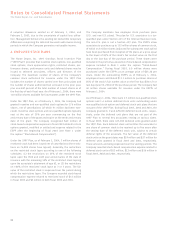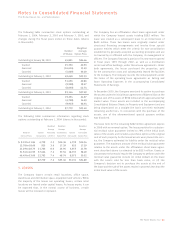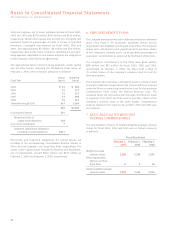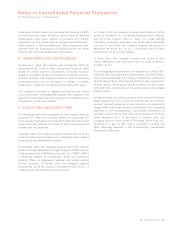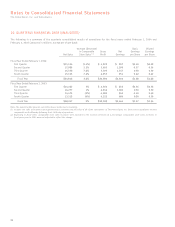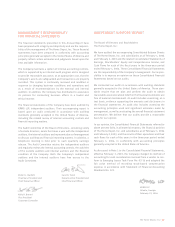Home Depot 2003 Annual Report Download - page 29
Download and view the complete annual report
Please find page 29 of the 2003 Home Depot annual report below. You can navigate through the pages in the report by either clicking on the pages listed below, or by using the keyword search tool below to find specific information within the annual report.
The Home Depot, Inc. | 27
Notes to Consolidated Financial Statements
The Home Depot, Inc. and Subsidiaries
Investments
The Company’s investments, consisting primarily of high-grade
debt securities, are recorded at fair value based on current
market rates and are classified as available-for-sale. Changes in
the fair value of investments are included in Accumulated Other
Comprehensive Income (Loss), net of applicable taxes in the
accompanying Consolidated Financial Statements. The Company
classifies its investments with an original maturity of less than
one year and those investments it intends to sell within one year
as current assets.
Income Taxes
The Company provides for federal, state and foreign income taxes
currently payable, as well as for those deferred due to timing
differences between reporting income and expenses for financial
statement purposes versus tax purposes. Federal, state and for-
eign tax benefits are recorded as a reduction of income taxes.
Deferred tax assets and liabilities are recognized for the future
tax consequences attributable to differences between the financial
statement carrying amounts of existing assets and liabilities and
their respective tax bases. Deferred tax assets and liabilities are
measured using enacted income tax rates expected to apply to
taxable income in the years in which those temporary differences
are expected to be recovered or settled. The effect of a change in
tax rates is recognized as income or expense in the period that
includes the enactment date.
The Company and its eligible subsidiaries file a consolidated U.S.
federal income tax return. Non-U.S. subsidiaries, which are
consolidated for financial reporting purposes, are not eligible to
be included in the Company’s consolidated U.S. federal income
tax return. Separate provisions for income taxes have been deter-
mined for these entities. The Company intends to reinvest the
unremitted earnings of its non-U.S. subsidiaries and postpone
their remittance indefinitely. Accordingly, no provision for U.S.
income taxes for non-U.S. subsidiaries was recorded in the
accompanying Consolidated Statements of Earnings.
Depreciation and Amortization
The Company’s Buildings, Furniture, Fixtures and Equipment are
depreciated using the straight-line method over the estimated
useful lives of the assets. Leasehold improvements are amortized
using the straight-line method over the life of the lease or the use-
ful life of the improvement, whichever is shorter. The Company’s
Property and Equipment is depreciated using the following
estimated useful lives:
Life
Buildings 10-45 years
Furniture, Fixtures and Equipment 5-20 years
Leasehold Improvements 5-30 years
Computer Equipment and Software 3-5 years
Capitalized Software Costs
The Company capitalizes certain costs related to the acquisition
and development of software and amortizes these costs using the
straight-line method over the estimated useful life of the software,
which is three years. Certain development costs not meeting the
criteria for capitalization are expensed as incurred.
Revenues
The Company recognizes revenue, net of estimated returns, at the
time the customer takes possession of merchandise or receives
services. When the Company receives payment from customers
before the customer has taken possession of the merchandise or
the service has been performed, the amount received is recorded
as Deferred Revenue in the accompanying Consolidated Balance
Sheets until the sale or service is completed.
Service Revenues
Net Sales include service revenues generated through a variety of
installation and home maintenance programs. In these programs, the
customer selects and purchases materials for a project and
the Company provides or arranges professional installation.
Under certain programs, when the Company provides the installa-
tion of a project and the material as part of the installation, both
the material and labor are included in service revenues.
In August 2003, the Company adopted Emerging Issues Task
Force (“EITF”) 00-21, “Revenue Arrangements with Multiple
Deliverables” (“EITF 00-21”) which establishes standards for the
recognition of revenue from arrangements with multiple deliver-
ables. Under EITF 00-21, if the product is contingent upon the
service, revenue for both the service and product is recognized at
the time the service is complete. The adoption of EITF 00-21 did
not have any impact on the Company’s Consolidated Financial
Statements as the Company was previously recognizing revenue
in accordance with the criteria set forth under this pronouncement.
All payments received prior to the completion of services are
recorded in Deferred Revenue in the accompanying Consolidated
Balance Sheets. Net service revenues, including the impact of
deferred revenue, were $2.8 billion, $2.0 billion and $1.6 billion
for fiscal 2003, 2002 and 2001, respectively.
Self Insurance
The Company is self-insured for certain losses related to general
liability, product liability, workers’ compensation and medical
claims. The expected ultimate cost for claims incurred as of the
balance sheet date is not discounted and is recognized as a
liability. The expected ultimate cost of claims is estimated based
upon analysis of historical data and actuarial estimates.


